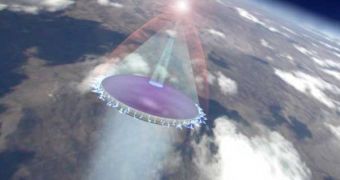At the Henry T. Nagamatsu Laboratory of Hypersonics and Aerothermodynamics at the IEAv-CTA, in Sao Jose dos Campos, Brazil, new types of rocket-propulsion systems are currently underway. The most advanced do not rely on chemical reactions, such as burning liquid oxygen and hydrogen, but on harnessing the power of lasers to effectively “beam” a spacecraft into orbit, or from one side of the planet to the other in less than an hour.
Behind the new test is the 30-year experience of Rensselaer Polytechnic Institute aerospace engineering professor Leik Myrabo. The expert's research has been focused on directed energy applications, aerospace systems, space prime power, and advanced propulsion, Space reports. Through his Bennington, Vt.-based company Lightcraft Technologies, Inc., the scientist has been trying out new propulsion systems, to replace the aging and unreliable ones already in existence. “Typically, a new propulsion technology takes 25 years to mature... to the point where you can actually field it. Well, that time is now,” he says.
“In the lab we're doing full-size engine segment tests for vehicles that will revolutionize access to space. It's real hardware. It's real physics. We're getting real data (...) and it's not paper studies. Right now, we're chasing the data. When you fire into the engine, it's a real wallop. It sounds like a shotgun going off inside the lab. It's really loud,” he shares about the work being done in Brazil. All research is conducted in a hypersonic shock tunnel, which is linked to two pulsed infrared lasers. The energy levels required to operate the ensemble are in the gigawatt range.
“The physics of high-power beamed energy propagation through the atmosphere (...) there's not a lot of expertise out there to make this stuff real. It's completely out of the conventional box. I've been working on it for 30 years. I know how to do it. We're here now. It's a matter of will and do we want to do it. This technology is now at the cusp of commercial reality,” Myrabo adds. The first Lightcraft prototypes were flown between 1996 and 1999, atop a ten-kilowatt, high-power, infrared laser. The record was established in 2000, when one of his laser-boosted vehicles reached an altitude of 230 feet (71 meters) in free flight.

 14 DAY TRIAL //
14 DAY TRIAL //